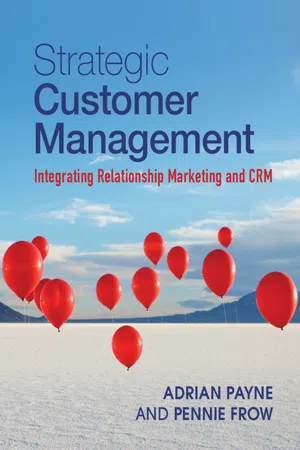Marketing
Marketing Management
Marketing management involves the planning, implementation, and control of marketing programs, resources, and activities to achieve organizational goals. It encompasses activities such as market research, product development, pricing, promotion, and distribution. The primary focus is on understanding customer needs and creating value through the delivery of products and services.
Written by Perlego with AI-assistance
Related key terms
1 of 5
9 Key excerpts on "Marketing Management"
- eBook - PDF
- James Burrow(Author)
- 2020(Publication Date)
- Cengage Learning EMEA(Publisher)
Cengage Learning reserves the right to remove additional content at any time if subsequent rights restrictions require it. 604 CHAPTER 22 | Take Control with Management be coordinated with the others. Products must be distributed in the time and the way that salespeople and advertisers expect, so promises to customers can be kept. Product development costs must match the amounts budgeted to uphold pricing decisions. Marketing Management is the pro- cess of coordinating resources to plan and implement an efficient marketing strategy. (Recall that a marketing strategy is the way marketing activities are planned and coordinated to achieve an organization’s goals.) Marketing managers are responsible for the success of the organization’s mar- keting efforts. Those marketing efforts are all of the activities involved in planning and implementing a marketing strategy. They manage the people and resources needed to identify markets and plan mar- keting mixes. Marketing managers also coordinate the work of the various compa- nies involved as products move through a channel of distribution. The channel may include a manufacturer, transportation company, finance company, wholesaler, retailer, advertising agency, and others. According to the marketing concept, effective marketing results in satisfy- ing exchanges. Marketing managers are successful when customers in the target markets are satisfied and the company is profitable. As a team, create a dia- gram of the marketing mix with each mix element identi- fied. Draw a line from one element to another and discuss how a problem in one element can have a negative effect on the other elements. Con- nect each element with another until all of the relationships have been discussed. - eBook - PDF
- O. C. Ferrell, Michael Hartline, O. C. Ferrell, Michael Hartline, Bryan Hochstein(Authors)
- 2021(Publication Date)
- Cengage Learning EMEA(Publisher)
Marketing Strategy This section of the marketing plan outlines how the firm will achieve its marketing objectives. In Chapter 1, we said that marketing strategies involve selecting and ana- lyzing target markets and creating and maintaining an appropriate marketing program (product, distribution, promotion, and price) to satisfy the needs of those target markets. It is at this level where the firm will detail how it will gain a competitive advantage by doing something better than the competition: Its products must be of higher quality than competitive offerings, its prices must be consistent with the level of quality (value), its distribution methods must be as efficient as possible, and its promotions must be more effective in communicating with target customers. It is also important that the firm attempts to make these advantages sustainable. Thus, in its broad- est sense, marketing strategy refers to how the firm will manage its relationships with customers in a manner that gives it an advantage over the competition. Marketing Implementation The implementation section of the marketing plan describes how the marketing program will be executed. This section of the marketing plan answers several questions with respect to the marketing strategies outlined in the preceding section: 1. What specific marketing activities will be undertaken? 2. How will these activities be performed? 3. When will these activities be performed? 4. Who is responsible for the completion of these activities? 5. How will the completion of planned activities be monitored? 6. How much will these activities cost? Without a good plan for implementation, the success of the marketing strategy is seriously jeopardized. For this reason, the implementation phase of the marketing plan is just as important as the marketing strategy phase. You should remember, too, that implementation hinges on gain- ing the support of employees: Employees implement marketing strategies, not organizations. - eBook - PDF
- (Author)
- 2010(Publication Date)
- Harvard Business Review Press(Publisher)
Understanding Marketing: The Basics What Is Marketing? 3 4 Understanding Marketing W hat’s the first thing you think of when you hear the word marketing ? Do you imagine salespeople talking up their company’s products with potential customers? Flashy billboard ads lining a highway? Finance managers calculating the possible profits that a new product may bring in? If you envisioned any or all of these things, you’re on the right track: selling, advertising, and profitability calculations are all impor-tant parts of marketing. But marketing consists of so much more. In the pages that follow, we’ll examine a definition of market-ing, explore how marketing connects with an organization’s mis-sion, see how a marketing orientation works and how it connects to customers’ needs, examine several approaches to marketing, and review the marketing process. A definition The following is a comprehensive definition of marketing: MARKETING is the process of planning and executing the concep-tion, pricing, promotion, and distribution of ideas, goods, and services to create exchanges that satisfy individuals’ and companies’ goals. Marketing isn’t somebody’s responsibility—[it’s] everyone’s responsibility. —Jack Welch What Is Marketing? 5 Marketing and mission: A close connection Marketing starts with the organization’s mission, which answers the following questions: • How does the organization define itself ? • What are its goals? • Who are its customers? • How does it intend to fulfill its mission? • What is the company’s very reason for existence? For example, “Company ABC’s mission is to provide low-pollution cars at a price that customers consider affordable and to foster its employees’ and shareholders’ achievement of their per-sonal objectives.” Fulfilling an organization’s mission is the process of reaching its goals through the exchange of goods, services, and ideas. And it’s these activities that define the process of marketing. - eBook - ePub
- Olivier Mesly(Author)
- 2020(Publication Date)
- Auerbach Publications(Publisher)
CLV ), that is, the amount of profit that can be gained from customers’ lifetime usage of the deliverable. Managers sometimes devise various strategies to maximize use, including lending, offering different uses than the original (e.g., a sports venue turned into a museum), or rental or storage. In short, the marketing of the deliverable can be innovative!The learning objectives of this chapter are to understand what Marketing Management is, to recognize Marketing Management in daily life, and to make the link between project management and the six core components of Marketing Management: innovation, segmentation, positioning, targeting, differentiation, and loyalty building.2.2 Six Components of Marketing Management
We prefer to address the six components in the above-mentioned order but, in reality, there is many back-and-forths between them (see Figure 2.1 ).Figure 2.1 The six components of marketing plans for marketing feasibility of project analysis.Note : The six components of this model encompass all there is to address when doing marketing feasibility of project analysis.Simple definition: Marketing Management is about innovation, segmentation, positioning, targeting, differentiation, and loyalty building.2.2.1 Innovation
Innovation is an intrinsic characteristic of projects. It necessitates walking off the normal paths set for doing things: This is what makes projects so exciting. When discussing research, some authors have said “… any significant research requires that one tries out new paths and faces ambiguity to define new variables ….”1 Indeed, projects are spoiled with ambiguity and unknown variables, which in turn make them good targets for points of vulnerability (POV - eBook - PDF
- James Burrow, Brad Kleindl, Michael Becraft, , James Burrow, Brad Kleindl, Michael Becraft(Authors)
- 2016(Publication Date)
- Cengage Learning EMEA(Publisher)
The marketing plan is a detailed written description of all mar-keting activities that a business must accomplish in order to sell its products. It describes the goals the business wants to accomplish, the target markets it wants to serve, the marketing mixes it will use for each product, and the tactics that make up the marketing strategy. It identifies the ways in which the business will evaluate its marketing to determine if the activities were successful and the goals were accom-plished. The marketing plan is written for a specific time period, such as one year. The marketing managers develop the marketing plan, based on information from many other staff members. Market research is very important in developing a marketing plan. Once a written plan is completed, all of the people involved in marketing activities can use it to guide their decisions about each marketing mix element and to coordinate their efforts as they complete the planned activities. SUCCESSFUL MARKETING STRATEGIES Marketing managers cannot afford to guess about which types of marketing mixes to use. Marketing is too expensive and customers have too many choices for businesses to risk making mistakes. Marketers use concepts such as the product life cycle and consumer goods categories to plan effective marketing mixes. For example, if the sales of a product are growing, the mix will be quite different than if the sales are relatively constant. If consumers view a product as a specialty good, marketers will emphasize different mix elements than if it is a convenience good. Marketers study markets and competition and use their knowledge of marketing to make decisions that will satisfy customer needs and result in a profit for the company. - eBook - ePub
Kellogg on Marketing
The Marketing Faculty of the Kellogg School of Management
- Alexander Chernev, Philip Kotler(Authors)
- 2023(Publication Date)
- Wiley(Publisher)
key value drivers that define the design of the offering. Specifically, the first three attributes—product, service, and brand—define the core benefits that the offering delivers to its customers, the price is the primary cost associated with the offering, and the incentives typically reduce the cost of the offering by modifying the price. Communication informs customers about the offering's value, and distribution involves delivering the offering to target customers. Regardless of the different ways in which they create market value—by contributing to the design, communication, or distribution aspect of the offering—the seven marketing tactics must be consistent with the overarching marketing strategy as well as aligned with one another in a way that helps create value for target customers, the company, and its collaborators.Creating Market Value: Strategy and TacticsFIGURE 3.4Source: Alexander Chernev, Strategic Marketing Management: Theory and Practice (Chicago, IL: Cerebellum Press, 2019).Managing the Implementation and Defining Controls
Setting a goal, defining the strategy, and designing the tactics reflect the way in which the company thinks about its offering. Indeed, these three aspects of Marketing Management, although crucial to the development of a successful offering, are only mental exercises that do not automatically create market value. To have market impact that will help the company achieve its goal, the company must implement its strategy and tactics and, at the same time, monitor the market performance of its offering. The processes of managing the implementation and defining marketing controls are discussed in more detail in the following sections.Managing Implementation
Marketing implementation is the process that turns a company's strategy and tactics into actions and ensures that they accomplish the company's goal. Implementation directly follows from a company's strategy and tactics, such that each decision is translated into a set of actions that make this decision a market reality. Implementation involves three key components: developing the company resources, developing the offering, and commercially deploying the offering.Developing the company resources - eBook - PDF
- Dawn Iacobucci(Author)
- 2021(Publication Date)
- Cengage Learning EMEA(Publisher)
1 Why Is Marketing Management Important? Some business leaders are born marketers, others have marketing thrust upon them. Either way, whether you’re a person who has sought out marketing responsibilities in your career path or you have found marketing to be inexplicably a part of your new responsibilities, this book is intended to be helpful to both types of marketers. The philosophy and principles of marketing are so pervasive now that everyone’s job entails some marketing—namely, you have to think about the customer. ● For the brand manager or entrepreneur or consultant in you who wonders about your customers, ● For the financial analyst in you determining a brand’s worth or wondering about a marketing campaign’s ROI, ● For the CMO or CEO in you who must oversee a breadth of responsibilities including marketing to ensure a long-term healthy and wealthy company, a knowledge of all the interworking elements of marketing, these days, is a must. This chapter begins with an overview of marketing concepts and terms. We’ll see the importance of marketing in today’s companies and nonprofits. We’ll then look at the Marketing Framework that structures the book and gives you a systematic way to think about marketing—the 5Cs, STP, and 4Ps. Specifically, to give us grounding, we need to 1 Learning Objectives After you have finished this chapter, you should be able to: LO 1-1 Define marketing LO 1-2 Describe the role of marketing in relation to the consumer and the firm LO 1-3 Explain the importance of marketing within a firm LO 1-4 Describe how the “5Cs, STP, and 4Ps” enhance the marketing exchange between a consumer and a firm 5Cs Customer Company Context Collaborators Competitors STP Segmentation Targeting Positioning 4Ps Product Price Place Promotion Copyright 2022 Cengage Learning. All Rights Reserved. May not be copied, scanned, or duplicated, in whole or in part. Due to electronic rights, some third party content may be suppressed from the eBook and/or eChapter(s). - eBook - ePub
Marketing Management
Text and Cases
- Robert E Stevens, David L Loudon, Bruce Wrenn(Authors)
- 2012(Publication Date)
- Routledge(Publisher)
Chapter 5 Marketing Planning: Strategic PerspectivesChapter 5 begins the two-chapter sequence addressing the next stage of the effective Marketing Management process: planning (see Figure 5.1 ).Figure 5.1. The Effective Marketing Management ProcessMarketing managers who begin with adoption of a societal marketing orientation (SMO) feel it is important to understand before they plan. An integral part of the SMO is the desire to serve the short-and long-term needs of customers and society at a profit, and accomplish this objective better than competitors. Thus, we seek to first understand the market (i.e., consumers, competitors, and the financial implications of what we do) and then use that understanding to develop plans of how we can create mutually beneficial exchange relationships. This planning process occurs at two levels—a corporate level, which is referred to as strategic planning, and a product/market level, which is referred to as operational or marketing planning. This chapter addresses broader, strategic planning issues.Many of today’s most successful companies evolved out of an era in which they introduced a good product or service into a market which was ready to accept the product. Geographic growth was achieved by expanding to new markets and later by adding new products to build a complete line of products rather than concentrating on one. In many companies, growth just appeared to happen with little or no formal thought about the management processes that went into it.However, with significant shifts in economic, environmental, and competitive forces, most managers have now realized that for survival and growth to occur they must be much more aware of the impact of the decisions they are making and the management processes used to make these decisions. Two characteristics differentiate successful from less successful firms: (l) good management and (2) the development of a competitive advantage. Managers of successful firms tend to be action-oriented “strategic thinkers” who focus their attention on customers, markets, and competitors as well as internally on operations. They seem to be able to blend strategy development with strategy implementation through a whole process referred to as strategic management. - eBook - PDF
Strategic Customer Management
Integrating Relationship Marketing and CRM
- Adrian Payne, Pennie Frow(Authors)
- 2013(Publication Date)
- Cambridge University Press(Publisher)
We consider that the lack of clear de fi nitions and understanding of these different, but closely related, activities has negatively impacted the successful implementation of rela-tionship marketing and its more technological cousin CRM. In the following chapters we elaborate on these short descriptions in much more detail. As the title of this book CRM: Strategic management of relationships with customers, involving appropriate use of technology CRM Relationship Marketing: Strategic management of relationships with all relevant stakeholders RELATIONSHIP MARKETING Customer Management: Implementation and tactical management of customer interactions CUSTOMER MANAGEMENT Figure 1.1 The domain of strategic customer management 4 INTRODUCTION suggests, we focus primarily on strategic aspects that relate to relationship marketing and CRM and we do not address the tactical management of customer transactions (i.e., ‘ customer management ’ ) in detail. To set the development of relationship marketing and CRM in context, we now review the development of the marketing discipline. The development of the discipline of marketing Although marketing has its origins in the earliest forms of commerce, the widespread acceptance of the marketing concept by enterprises is relatively recent. The modern adoption of the marketing concept can be traced to the substantial period of growth following the Second World War. The adoption of marketing was especially prevalent in large US companies over this period. Little marketing literature was published prior to the 1950s. Since the 1950s the formal study of marketing has focused on an evolving range of marketing sectors and foci, as shown in Figure 1.2 . The emergence and development of these sectors do not coincide exactly with the decades show in Figure 1.2 . However, these decades broadly represent the starting point of substantive research and the appearance of academic and practitioner publications relating to these sectors.
Index pages curate the most relevant extracts from our library of academic textbooks. They’ve been created using an in-house natural language model (NLM), each adding context and meaning to key research topics.








